-
Paper Information
- Paper Submission
-
Journal Information
- About This Journal
- Editorial Board
- Current Issue
- Archive
- Author Guidelines
- Contact Us
Food and Public Health
p-ISSN: 2162-9412 e-ISSN: 2162-8440
2024; 14(2): 29-35
doi:10.5923/j.fph.20241402.01
Received: Aug. 8, 2024; Accepted: Aug. 29, 2024; Published: Aug. 31, 2024

A Comparison between Low Caloric versus Low Carbohydrate versus Human Chorionic Gonadotropin Diets on Serum Insulin and Leptin in High Fat Induced Obesity in Male Rats in Egypt
Ashraf Kotb1, Ayman S. Soliman2, Nora M. Abounar3, Yasmine Hamdy Eisa4, Safy S. Gaber5
1Assistant Professor of Medical Physiology, Faculty of Medicine, October 6 University, Giza, Egypt
2Assistant Professor of Medical Physiology, Faculty of Medicine, Beni-Suef University, Beni-Suef, Egypt
3Assistant Lecturer of Medical Physiology, Faculty of Medicine, October 6 University, Giza, Egypt
4Lecturer of Public Health and Preventive Medicine, Faculty of Medicine, October 6 University, Giza, Egypt
5Lecturer of Medical Physiology, Faculty of Medicine, Beni-Suef University, Ben-Suef, Egypt
Correspondence to: Yasmine Hamdy Eisa, Lecturer of Public Health and Preventive Medicine, Faculty of Medicine, October 6 University, Giza, Egypt.
| Email: |  |
Copyright © 2024 The Author(s). Published by Scientific & Academic Publishing.
This work is licensed under the Creative Commons Attribution International License (CC BY).
http://creativecommons.org/licenses/by/4.0/

Obesity is a chronic disease with unknown pathophysiological mechanism. The prevalence of obesity increases leading to many complications such as Type 2 Diabetes mellitus, fatty liver, and cardiovascular disease. Weight loss, via lifestyle changes such as dietary modifications and exercises, is one of the lines of treatment for obesity. The most effective types of diet and the optimal degree of energy restriction for treating obesity are still debatable. Our study was designed to compare the effect of low caloric, low carbohydrate, and human chorionic gonadotropin (HCG) diets on serum insulin and leptin. Obesity was induced in twenty- four adult male albino rats by a high fat diet. Then, rats were randomly allocated into four equal groups: control group, low caloric diet (LC) group, low carbohydrate diet (L-CHO) group, and (HCG) diet. Body weight and serum insulin levels were measured. Also, serum cholesterol, triglycerides, low-density lipoproteins, and leptin were measured. In our result, LC, L-CHO and HCG groups showed a significant decrease in body weight and lipid profile when compared with control group. Both the LC and L-CHO groups showed a significant decrease in serum insulin and a significant increase in serum leptin. However, a significant decrease in serum insulin and a significant increase in serum leptin showed a non-significant decrease in serum insulin and a non-significant increase in serum leptin. In conclusion, LC, L-CHO and HCG were effective in management of obesity and weight loss. However, LC diet is the most effective in decreasing serum insulin and lowering lipid profile.
Keywords: Obesity, Insulin, Leptin, Low caloric diet, Low carbohydrate diet, HCG diet
Cite this paper: Ashraf Kotb, Ayman S. Soliman, Nora M. Abounar, Yasmine Hamdy Eisa, Safy S. Gaber, A Comparison between Low Caloric versus Low Carbohydrate versus Human Chorionic Gonadotropin Diets on Serum Insulin and Leptin in High Fat Induced Obesity in Male Rats in Egypt, Food and Public Health, Vol. 14 No. 2, 2024, pp. 29-35. doi: 10.5923/j.fph.20241402.01.
Article Outline
1. Introduction
- Obesity has become a prevalent chronic illness. Over 1.9 billion persons over the age of 18 are overweight (26%) and 650 million are obese (13%), according to the World Health Organization. Note that obesity currently causes significantly more deaths than underweight does in the majority of countries, and that the prevalence of overweight and obesity is rising even in developing countries [1]. Obesity is regarded as a chronic medical illness with a complex pathophysiology. It is known that a combination of environmental interactions, dietary choices, food quality, psychological factors, and hereditary factors contributes to the development of obesity and its associated metabolic abnormalities [2]. Obesity raises the risk of cardiovascular illnesses (hypertension, myocardial infarction, stroke), metabolic diseases (such as type 2 diabetes mellitus and fatty liver disease), and several types of cancer (for example, breast, ovarian, prostate, liver, kidney and colon) [3]. In addition, obesity has been linked to decreased fertility, hypogonadism in males and polycystic ovarian syndrome in women. Insulin resistance and leptin resistance may be the most widely accepted explanation for why obese women have decreased fertility [4]. An adipokine called leptin plays a key role in maintaining a healthy energy balance and controlling weight. As a result of leptin's stimulation of various hypothalamic nuclei, satiety and weight loss are encouraged. Additionally, leptin and insulin interact, affecting the equilibrium of lipids and glucose. Serum leptin increases in the fed state, drops in the fasting state, and is strongly connected with total body fat mass: greater adipose tissue means more leptin, which reflects the availability of long-term energy [5]. For the treatment of overweight and obesity, there are currently a number of nutritional, physical activity, behavioral, pharmacological, and surgical options available. In order to manage obesity, nutrition therapy is necessary. Calorie restriction is known to be essential for establishing both glycemic control and desirable lipid profiles [6]. It has been controversial to determine the best diets for managing weight. A low-calorie diet (LC) consists of consuming 1,000–1,500 calories per day, although several obesity societies and guidelines prescribe deficits of 500–750 calories per day for weight loss [7]. But the Low-Carbohydrate Diet (L-CHO) stands out among all the other diets. There are many different carbohydrate-restricted diets, but low-carbohydrate diets have become popular for managing type 2 diabetes as well as weight loss. A low-carbohydrate diet is one where the daily carbohydrate intake is less than 10%, or 20–50 grams [8]. In the 1950s, Dr. Albert Simeons pushed his revolutionary human chorionic gonadotropin (HCG) injections in conjunction with an extremely low-calorie diet of 500 calories per day. This led to the rise in popularity of the HCG diet. The need of calories for fetal maintenance during pregnancy is the suggested mechanism for weight loss. The weight loss technique promises to shift body fat from the hips, thighs, and stomach in non-pregnant users without having any negative side effects like hunger or irritability. The Food and Drug Administration is not required to regulate its content because it can be purchased over-the-counter and online, which leads to a lack of reliable safety and efficacy data among patients who use these products as weight reduction assistance [9]. Based on the above, the present study was designed to find out which is more effective in treatment of obesity, whether a low caloric diet or low carbohydrate diet or HCG diet.
2. Materials and Methods
- • Experimental animals: Twenty- four adult male and female albino rats, eight weeks of age, weighing 140 ± 10 g were used in the current study. Rats were obtained from the animal house of Kasr Al Aini Faculty of Medicine, Cairo University, Egypt. Rats were kept under observation for about 15 days before the onset of the experiment for adaptation and to exclude any inter-current infection. They were housed in plastic cages (three per cage) with well-aerated covers at normal temperature (25±5°C) with 12 hours light/dark cycles. Rats were given free water access and supplied daily with laboratory rat diet offered ad-lib. All protocols used were approved by the Beni-Suef University Ethical Committee and were conducted in accordance with National Institutes of Health Guidelines for the Care and Use of Laboratory Animals.• Animals grouping: Obesity was induced in the rats of this study by high fat diet for six weeks [10]. Then, rats were further subdivided into four equal subgroups (n=6):a. Obesity control group: Rats were given normal rat diet for four weeks, kept under the same laboratory conditions and were regarded as control group for other ones. Normal diet composed of (wt/wt): 5.4% fat, 53.8% carbohydrate, 21.9% protein, 2.9% fibre, 6.6% minerals, added vitamins A, D, and E, and 0.02% cholesterol [11]. a. Low caloric (LC) diet group: Rats were given low-caloric diet for 4 weeks [12]. b. Low carbohydrate (L-CHO) diet group: Rats were fed low CHO diet for four weeks [13]. c. HCG diet group: Rats in this group were injected with 5 IU/day of HCG [14] in combination with an ultra-low-calorie diet of 500 calories per day [9].• Techniques:A. Samples collectionThe blood samples were collected retro-orbitally at the end of the experiment then centrifuged at 3000 rpm for 15 minutes, and serum was separated and stored at -20°C. The serum was divided into different tubes for further determination of biochemical markers.B. Biochemical techniques:i. Measuring fasting serum insulin level: At the end of the experiment, 12h fasting blood samples were obtained to determine serum insulin level by insulin enzyme-linked immunosorbent assay (ELISA) Kits according to [15]. ii. Measuring serum Leptin: Serum leptin was assessed by leptin ELISA kits according to [16]. iii. Measuring serum low-density lipoprotein (LDL): Serum LDL level was assessed by LDL (ELISA) kits according to [17]. iv. Measuring serum total cholesterol (TC): Serum TC level was assessed by TC (ELISA) kits according to [18]. v. Measuring serum triglycerides (TG): Serum TG level was assessed by TG (ELISA) kits according to [19]. C. Statistical methods:Data were coded and entered using the statistical package SPSS version 24. Data were summarized using mean and standard deviation for quantitative variables. Comparisons between analysis of variance (ANOVA) with multiple comparisons post hoc test [20]. P-values less than 0.05 were considered as statistically significant.
3. Results
- I. Comparison of body weight and serum lipid profile in the studied groups: (Table 1 and figures 1, 2(A,B,C) )Regarding body weight, there was a significant decrease in body weight (P<0.05) in LC group, L-CHO group and HCG group when compared with control group by (- 19.84%), (- 17.87%) and (- 1.66%) respectively. However, there was a non-significant higher body weight in L-CHO group when compared to LC group. In addition, HCG group showed a significant (P<0.05) increase in body weight by (+ 9.08%) when compared to LC group and by (+6.47%) when compared with L-CHO group.In our study, serum TC showed a significant decrease (P<0.05) in LC group, L-CHO group and HCG group when compared to control group by (- 52.42%), (- 42.58%), and (- 42.33%) respectively. Serum TC was significantly higher in L-CHO group when compared with LC group with non-statistically significant difference between L-CHO group and HCG group regarding serum TC.In addition, serum LDL showed a significant decrease (P<0.05) in LC group, L-CHO group and HCG group when compared to control group by (- 58.67%), (- 57.27%), and (- 51.22%) respectively. Serum LDL was significantly higher in L-CHO group when compared with LC group. Also, serum LDL was significantly higher in HCG group when compared to both LC group and L-CHO group.Regarding serum TG, there was a significant decrease (P<0.05) in LC group, L-CHO group and HCG group when compared to control group by (- 38.36%), (- 34.79%), and (- 22.16%) respectively. Serum TG was significantly higher in L-CHO group when compared with LC group. Also, serum TG was significantly higher in HCG group when compared to both LC group and L-CHO group.
|
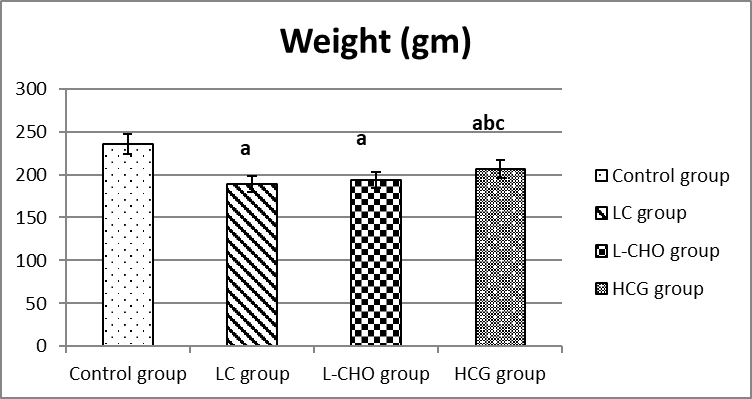 | Figure (1). Comparison of body weight between the studied groups |
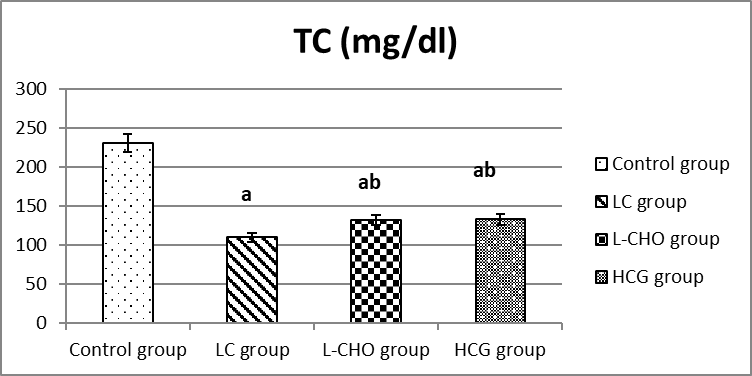 | Figure (2A). Comparison of serum lipid profile between the studied groups |
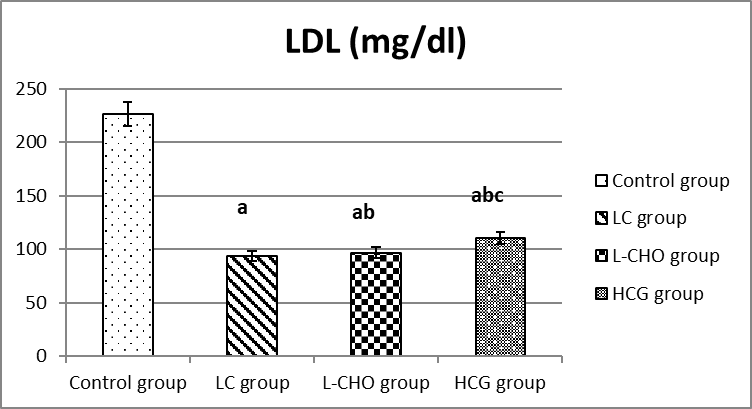 | Figure (2B). Comparison of serum lipid profile between the studied groups |
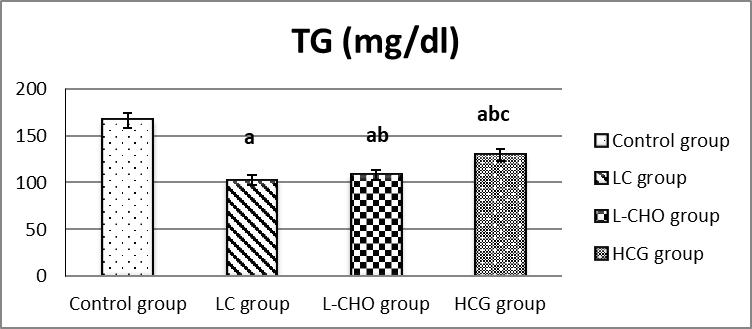 | Figure (2C). Comparison of serum lipid profile between the studied groups |
|
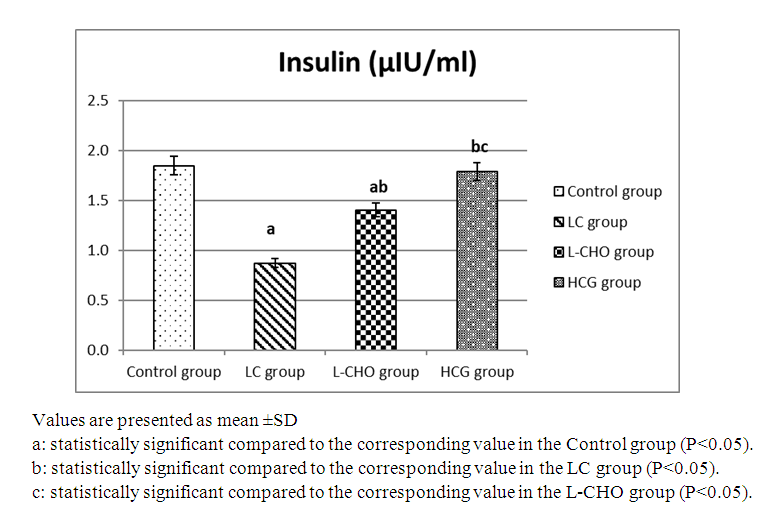 | Figure (3). Comparison of serum insulin between the studied groups |
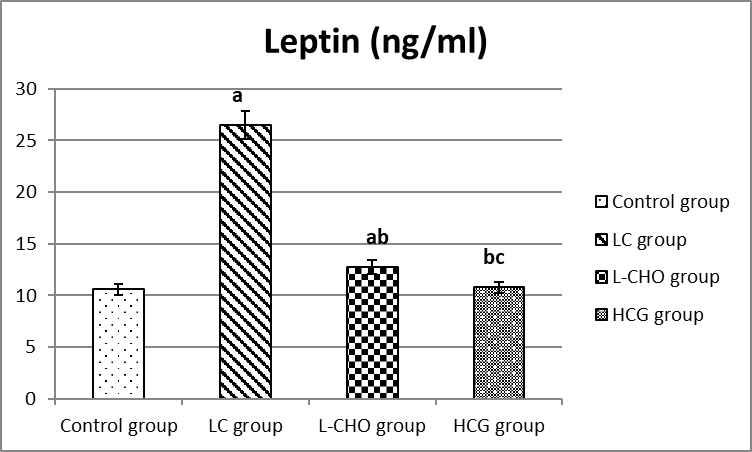 | Figure (4). Comparison of serum leptin between the studied groups |
4. Discussion
- Obesity is a widespread public health problem that affects people of all ages. Since it affects people's health and quality of life, it has a large social and economic impact. Controlling body weight and adiposity through a negative energy balance, in which both nutrition and exercise are crucial, is a key component of the treatment and prevention of obesity [21]. Diets remain the most popular choice that represents some of the most important clinical treatments of obesity. The present study was designed to find which is more effective in decreasing body weight, whether a low caloric diet, low carbohydrate diet, or HCG diet on a high fat-induced obesity in adult male albino rats.Animals are frequently given high-fat diets to make them gain weight because eating these diets can make people gain weight as well because they raise body adiposity, cause leptin resistance, and encourage the development of hypertension and glucose intolerance [21].Regarding body weight, there was a significant decrease in body weight in LC group, L-CHO group and HCG group when compared with control group. However, there was a non-significant higher body weight in L-CHO group when compared to LC group. In addition, HCG group showed a significant increase in body weight when compared to LC group and L-CHO group. This is in line with a previous study which proved that low caloric intake produces weight loss [6]. An energy deficit is another essential element of diets for weight loss and weight maintenance. According to evidence, numerous obesity organizations advise following a low-calorie diet as a key weight-loss recommendation [22].The most effective technique to reduce weight is through an energy deficit, however following a successful weight reduction, weight rebound is relatively common. Low-carbohydrate diets have been used extensively to control type 2 diabetes mellitus in addition to weight loss [23].In addition, our result is in the line with previous studies which proved that exogenous HCG hormonal therapy results in weight loss by increasing metabolic consumption and fat redistribution [14,24].In contrast to our results, although the American Society of Bariatric Physicians acknowledges that the HCG diet does not actually help people lose weight, it is nonetheless frequently promoted to consumers. Furthermore, prior research indicated that caloric restriction appears to be the primary contributing reason to the weight reduction that is related with HCG diet regimens [9].Our results showed a significant improvement in lipid profile (TC, LDL, and TG) in LC group, L-CHO group and HCG group when compared to control group. However, L-CHO group showed a significant higher lipid profile (TC, LDL, and TG) than LC group. Moreover, HCG group showed a significant higher lipid profile (TC, LDL, and TG) when compared to both LC group and L-CHO group with non-statistically significant difference between L-CHO group and HCG group regarding serum TC.Our result is in agreement with previous studies that concluded a significant improvement in serum total cholesterol, triacylglycerol, and LDL concentration with low caloric diet [25,26].Similar results were achieved by previous studies of [27-29]. which proved that using a low carbohydrate diet had greater improvements in lipid profile.According to a prior study, HCG suppresses lipogenesis. However, because fat cell membranes lack hCG receptors, these effects do not directly affect adipocytes [30].Our results show a significant decrease in serum insulin level in LC group and L-CHO group when compared to control group with non-significant decrease in HCG group when compared to control group. However, serum insulin was significantly higher in L-CHO group when compared with LC group. Also, serum insulin was significantly higher HCG group when compared to both LC group and L-CHO group.Our result is in agreement with [27] who proved that using a low caloric diet had greater improvements in reducing serum insulin level. In addition, previous findings also suggest that low‐carbohydrate diets decrease insulin level [29,31].In contrast to our results, a previous study reported that HCG diet may be one treatment that treats obesity and insulin resistance [32]. Leptin is synthesized by fat cells and acts as a satiety factor at the hypothalamus mediated through the leptin receptor [38], it circulates in relation to body energy reserves and dietary accessibility. Leptin encourages satiety and controls weight and energy balance. Leptin resistance caused by diet-induced obesity exacerbates overeating. Adipocytes release leptin, which crosses the blood-brain barrier and acts on the hypothalamus to indicate satiety and reduce appetite and food intake when energy reserves are high [5].Our results showed a significant increase in serum leptin in LC group and L-CHO group when compared to control group with non-significant increased serum leptin in HCG group when compared to control group. However, serum leptin was significantly lower in L-CHO group when compared with LC group. Also, serum leptin was significantly lower in HCG group when compared to both LC group and L-CHO group.This is in line with [33] who showed that with calorie restriction serum leptin increased.In addition, our results is in agreement with a previous study of [34] who used a carbohydrate-restricted diet showed a significant increase in serum leptin level. Also, in the line with a previous study which proved that the proadipogenic hormone leptin is secreted from human adipose tissue under the influence of HCG [35]. Additionally, the combination of the 500 calorie diet with hCG injections provided dieters with a considerable benefit, increasing weight reduction and decreasing hunger [36].In contrast to our results, previous studies revealed there is no scientific proof that HCG is useful in treating obesity; it does not cause weight reduction or fat redistribution, nor does it do anything to control hunger or improve mood [37].
5. Conclusions
- Treatment of obesity with low-caloric diet and low- carbohydrate diet showed a significant decrease in body weight and serum insulin level with a significant increase in serum leptin and a significant improvement in the lipid profile Thus, Both diets may be effective in weight loss designing therapy for obesity.In addition, HCG diet significantly decreased body weight and serum lipid profile without significant improvement in serum insulin or leptin levels.We can conclude that there is no single best strategy for weight management, although low daily calorie intake is the most important factor for weight loss.Our study has some limitations. We focused mainly on body mass reduction, serum insulin, and leptin. We did not evaluate the possible adverse effects of the LC, L-CHO, and HCG diets on liver, kidney, and cardiovascular system. Another limitation of this study is the assessment the diets for a short period. Also, our intention was to check the effects of different composition of macronutrients in the diets for long term period. All these limitations should be considered in the future research.We recommend that it is possible to use low-caloric diet and low- CHO diet in reducing body weight, serum insulin, and lipid profile in obesity and improvement of serum leptin level. Although low-caloric diet, low- CHO diet and HCG diets help in alleviation of lipid profile and insulin, it was not complete. So, these data should be considered when treating insulin sensitivity and lipid profile in obese patient. However, the current work raises the need for further clinical studies to assess the benefits of Low-caloric diet, low- CHO diet and HCG diets in obese patients.
Declarations
- Conflict of interest: The authors declare that there are no conflicts of interest.Funding: No external funding sources are relevant to this submission.Contribution to authorship: All authors were involved in the writing of the manuscript and all authors made the decision to submit for publication.Data availability statement The data that support the findings of this study are available from the corresponding author, Yasmine Hamdy Eisa, upon reasonable request.
 Abstract
Abstract Reference
Reference Full-Text PDF
Full-Text PDF Full-text HTML
Full-text HTML
